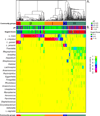Vaginal microbiome: rethinking health and disease
- PMID: 22746335
- PMCID: PMC3780402
- DOI: 10.1146/annurev-micro-092611-150157
Vaginal microbiome: rethinking health and disease
Abstract
Vaginal microbiota form a mutually beneficial relationship with their host and have a major impact on health and disease. In recent years our understanding of vaginal bacterial community composition and structure has significantly broadened as a result of investigators using cultivation-independent methods based on the analysis of 16S ribosomal RNA (rRNA) gene sequences. In asymptomatic, otherwise healthy women, several kinds of vaginal microbiota exist, the majority often dominated by species of Lactobacillus, while others are composed of a diverse array of anaerobic microorganisms. Bacterial vaginosis is the most common vaginal condition and is vaguely characterized as the disruption of the equilibrium of the normal vaginal microbiota. A better understanding of normal and healthy vaginal ecosystems that is based on their true function and not simply on their composition would help better define health and further improve disease diagnostics as well as the development of more personalized regimens to promote health and treat diseases.
Figures



References
-
- Alpay-Karaoglu S, Aydin F, Kilic SS, Kilic AO. Antimicrobial activity and characteristics of bacteriocins produced by vaginal lactobacilli. Turk. J. Med. Sci. 2002;33:7–12.
-
- Amsel R, Totten PA, Spiegel CA, Chen KC, Eschenbach D, Holmes KK. Nonspecific vaginitis: Diagnostic criteria and microbial and epidemiologic associations. Am. J. Med. 1983;74:14–22. - PubMed
-
- Antonio MA, Hawes SE, Hillier SL. The identification of vaginal Lactobacillus species and the demographic and microbiologic characteristics of women colonized by these species. J. Infect. Dis. 1999;180:1950–1956. - PubMed
Publication types
MeSH terms
Grants and funding
LinkOut - more resources
Full Text Sources
Other Literature Sources
Medical

